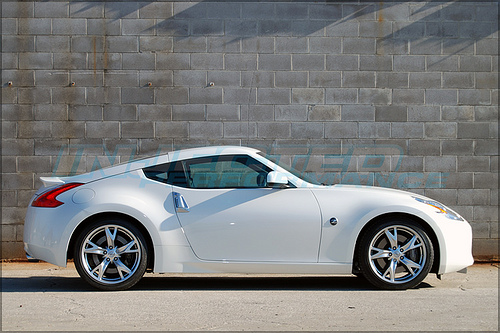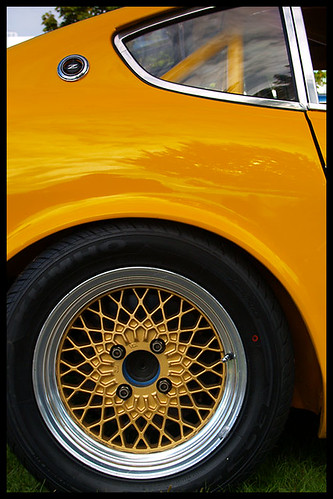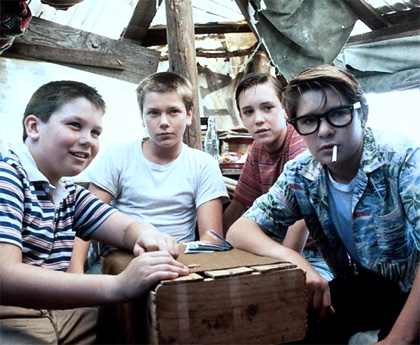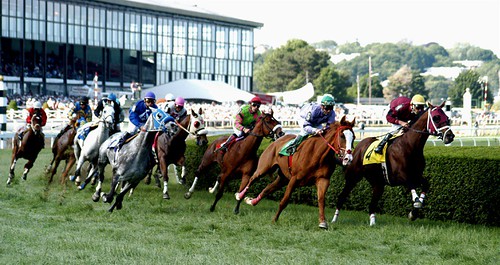Formed from the remnants of one of my favorite bands of all time, Mclusky, The Future of the Left once again make rock and roll feel cool. Their initial release Curses while a little heavy on the synth was still impressive, their sophomore effort Travels with Myself and Another has been on heavy rotation. Mixing the raw guitar riffs that drove of Mcluskys early releases with more polished and well layered vocals FotL creates a sound that I can only describe as awesome. Lyrically Andy "Falco" Falkous remains as comedic as always but seems to have a more serious, directed note to his words. I hate to describe bands as growing up but this seems to be exactly what the members of Future of the Left have done, this isn't to say they have lost any of their edge. They still have crafted an album that makes you want to get up, start drinking, and do something that you will undoubtedly regret. The well articulated sound and more intelligible lyrics are just an added bonus to the pulse pounding sound that they seemed to have mastered. I could continue on in praise of FotL but I'll keep this short and just let your hear it for yourself.
Wednesday, September 30, 2009
Vermouth
Vermouth is most widely known in America as 'the other' ingredient in Martinis and Manhattans and is often treated with extreme caution. Maybe unsurprisingly the view of it in Europe is quite the opposite, where it is a much more appreciated liquor and often served as an aperitif. In America vermouth still remains almost an enigma, known as a strong flavored alcohol that mixes well into the cocktails where it is called for but not receiving much attention into most bars signature drinks.
 Big hat, tiny glass, decent vermouth
Big hat, tiny glass, decent vermouthThe exact origins of vermouth are somewhat convoluted, most of this confusion seems to come from its name. At its base vermouth is simply wine that has been fortified, normally with brandy, and then flavored with various herbs. Antonio Benedetto Carpano of Turin Italy is acknowledged to have been the person to coin the term vermouth for the aromatized wine he had been producing. It is said that he took the name vermouth form the German word Wermut meaning Wormwood. Supposedly he took this name because of the popularity of German fortified wine that was often flavored with Wormwood. although Carpono is credited with the coining of the term Vermouth, the actual history 0f fortified wines infused with Mediterranean herbs stretches back centuries. As with many liquors, especially those infused with herbs, the original intent was that of a tonic. The herbs that are contained in vermouth were not only added for flavor but often for the healing properties they were supposed to possess. It is notable that wormwood had been used as a treatment for intestinal worms as far back as ancient Greece. The production of herbed, fortified wine was common for many European households through the 17th century. It was not until the early 1800's that large scale production of specific styles of infused wines, such as vermouth, became popular.
By the mid 1800's three main companies were competing and producing vermouth in Italy: Carpano, Martini & Rossi and Cinzano. Martini & Rossi was formed by Alessandro Martini and Luigi Rossi in 1863. Both men had been employed in Turin by a distributor of wines and liquors and decided to try their hand at creating a vermouth that they hoped would be of the highest quality and consistency possible. Their endeavor paid off, with their vermouth almost immediately receiving a grand price at Dublin in 1865. The vermouth would eventually claim 13 grand prizes by 1912. Brothers Giovanni and Carlo Cinzano began producing aromatic wines in the mid 1700's including their signature vermouth. The company became notable in 1840 for creating the first Italian sparkling wine, after the brothers had been chartered to create a wine to compete with french Champagnes which had been quickly gaining popularity. Cinzano has often been recognized for its advertising campaigns, often using exotic images to capture customers attention . The company was on one of the first adopters of both mail drop advertisements during the 30's and 40's and television advertising which helped their sales in the 70's. The Carpano group acquired the Cinzano brand in 1999 and is now the second largest retailer of vermouth in the world.
During this same time french company Noilly Prat would begin to produce a dry style vermouth. Noilly Prat was founded by a French herbalist Joseph Noilly who created a signature vermouth recipe in 1813 created a company base on in 1855 with his son in law Claudius Prat. The french Clairette and Picpoul grapes they used to make this dry vermouth also gave it its signature golden color compared to the red tone of Italian vermouth.
Most of the vermouth brands base much of their quality on their secret recipe of herbs. Noilly Pratt often advertises their secret blend of 20 different ingredients. The most common herbs that are found in vermouth blends are chamomile, bitter orange peel, nutmeg, century, coriander, and cloves. The aging process is also very specific, Noilly Prat for example uses 100 year old Canadian oak barrels for the first 8 months, and the a transfer to smaller barrels which are kept outside, as opposed to cellaring, to simulate the conditions seen by the barrels if they had been shipped across the ocean. During this time some of the vermouth is lost to evaporation, this amount has been referred to as the 'angles share'. In 1971 Martini & Rossi would purchase Noilly Prat making them the largest retailer of both french and Italian vermouth.
Cocktail Time
The Waldorf
The Waldorf Cocktail was one of the signature drinks of the
Waldorf-Astoria Bar at the beginning of the 20th Century
Waldorf-Astoria Bar at the beginning of the 20th Century
- 1 ounce bourbon
- 1 ounce sweet vermouth
- 1 ounce absinthe
Instructions: Combine ingredients in a mixing glass and fill with ice.
Stir well and strain into a chilled cocktail glass.
Gratuitous images for people who fear words
Sunday, September 27, 2009
Suffolk Downs
For most people one of two things comes when they hear the words "Horse Track". The first is the big hats, big wallets, and big juleps environment of the triple crown tracks or Del Mar. With expensive restaurants, reserved boxes and a valet lot full of European sports cars. The other picture that comes to mind is the gritty, probably rigged, definitely tied to the mob racing where most of the crowd is there because that's what they do for a living. Suffolk Downs mixes both of these visions, albeit unevenly towards the lower class side. It still has a shred of dignity, even though its a tattered and worn shred.
Suffolk Downs was originally opened in 1935 after the legalization of pari-mutel gambling in Massachusetts. Built on 200 acres of mudflats in East Boston next to what would become Logan International Airport. It was completed in 62 days and was designed to hold 16,000 fans, making it one of the biggest tracks of the time. Daily attendance remained above 10,000 people through the early 1970's. It has seen some notable horse come and go, most famously would be Seabiscuit. It has hosted concerts for some of the biggest acts of all time, such as the Beatles in 1966, or more recently Radiohead.
Going to Suffolk Downs is a great way to spend a Saturday, I enjoy the entertainment and the rush of gambling even if my bets are low risk and low value. The less than gentlemanly attitude of the track is interesting and somewhat satisfying. The entry is cheap, the beer is reasonably priced, the food is edible and the grounds are surprisingly well maintained. However all of these characteristics are what make trips to the track have a depressing note to them. The interior of the track is full of well maintained grass and a pond with a fountain. The grandstands have a nice outdoor seating area with benches that is attached to an enclosed box seating area that features an on track restaurant and automated betting. The outside of the facility is also well maintained with flower beds spotting the bright green grass on the main entryway. It does seem that this effort that is put into making the track a friendly environment to people who are there for entertainment and not to make a living is wasted. The indoor grandstands with the box seats are almost entirely empty, even on a crowded day. The outdoor benches seem to be only full of bored kids or people who stepped out for a smoke. The most crowded part of the facility is the one that is the least well kept. The racks of old television simulcasting races from all over the country, with rows of seats that look unfit for an airport are what draw the biggest crowds. Almost no attention goes to the races that are actually happening on site, at most a couple hundred people will walk out to cheer on the local jockeys.
Its often this juxtaposition of the almost aristocratic with the working class that gives it what I guess I would call "charm". The horse track has historically been a place where the lower class and the social elites were both accepted. It seems that Suffolk downs has taken a hard hit in the category of dignity, not that this is a bad thing. There is definitely something funny to me, although its probably the cynic in me, about scratch ticket vending machines, and empty bottles of crown royal in the ash trays. Though I'm sure a lot of the people who spend their days here have what would be called a problem, a definite majority are just older folks from the area who grew up spending days at the track, and will continue to do so.

After visiting a few other, more famous tracks, I definitely came to appreciate what Suffolk Downs can offer. What it offers is a guaranteed way to have a fun Saturday without a big hit on your wallet. No 15 dollar entry fee, no 9 dollar beers but with the same the chance that you might walk away a winner. It makes me wonder what keeps this place from being more crowded, especially on these sunny fall days where its too cold to swim but still perfect for sitting outside in the sun. I also wonder why there isn't a push to draw in more of Bostons 250,000 college students when its accessible via the subway, and costs under 20 dollars for a day of eating, drinking and gambling. Although this article may make Suffolk Downs seem like a downer, I will definitely co continue to return, because there's no way around it, the place has character.
As in previous articles, photos link to respective flikr's, please give them a look as many have lots of other interesting photos.
Suffolk Downs was originally opened in 1935 after the legalization of pari-mutel gambling in Massachusetts. Built on 200 acres of mudflats in East Boston next to what would become Logan International Airport. It was completed in 62 days and was designed to hold 16,000 fans, making it one of the biggest tracks of the time. Daily attendance remained above 10,000 people through the early 1970's. It has seen some notable horse come and go, most famously would be Seabiscuit. It has hosted concerts for some of the biggest acts of all time, such as the Beatles in 1966, or more recently Radiohead.
Going to Suffolk Downs is a great way to spend a Saturday, I enjoy the entertainment and the rush of gambling even if my bets are low risk and low value. The less than gentlemanly attitude of the track is interesting and somewhat satisfying. The entry is cheap, the beer is reasonably priced, the food is edible and the grounds are surprisingly well maintained. However all of these characteristics are what make trips to the track have a depressing note to them. The interior of the track is full of well maintained grass and a pond with a fountain. The grandstands have a nice outdoor seating area with benches that is attached to an enclosed box seating area that features an on track restaurant and automated betting. The outside of the facility is also well maintained with flower beds spotting the bright green grass on the main entryway. It does seem that this effort that is put into making the track a friendly environment to people who are there for entertainment and not to make a living is wasted. The indoor grandstands with the box seats are almost entirely empty, even on a crowded day. The outdoor benches seem to be only full of bored kids or people who stepped out for a smoke. The most crowded part of the facility is the one that is the least well kept. The racks of old television simulcasting races from all over the country, with rows of seats that look unfit for an airport are what draw the biggest crowds. Almost no attention goes to the races that are actually happening on site, at most a couple hundred people will walk out to cheer on the local jockeys.
Its often this juxtaposition of the almost aristocratic with the working class that gives it what I guess I would call "charm". The horse track has historically been a place where the lower class and the social elites were both accepted. It seems that Suffolk downs has taken a hard hit in the category of dignity, not that this is a bad thing. There is definitely something funny to me, although its probably the cynic in me, about scratch ticket vending machines, and empty bottles of crown royal in the ash trays. Though I'm sure a lot of the people who spend their days here have what would be called a problem, a definite majority are just older folks from the area who grew up spending days at the track, and will continue to do so.

After visiting a few other, more famous tracks, I definitely came to appreciate what Suffolk Downs can offer. What it offers is a guaranteed way to have a fun Saturday without a big hit on your wallet. No 15 dollar entry fee, no 9 dollar beers but with the same the chance that you might walk away a winner. It makes me wonder what keeps this place from being more crowded, especially on these sunny fall days where its too cold to swim but still perfect for sitting outside in the sun. I also wonder why there isn't a push to draw in more of Bostons 250,000 college students when its accessible via the subway, and costs under 20 dollars for a day of eating, drinking and gambling. Although this article may make Suffolk Downs seem like a downer, I will definitely co continue to return, because there's no way around it, the place has character.
As in previous articles, photos link to respective flikr's, please give them a look as many have lots of other interesting photos.
Thursday, September 24, 2009
The weekender
Anyone who's been following recent releases has seen a proliferation of "Weekender" bags, or normally known as a canvas duffel. Even though some are ridiculous priced, awkwardly detailed, or plain ugly it is nice to see the focus moving away from just clothing. A nice weekend bag is a pretty useful thing to own. Bigger than a backpack but not as arduous to carry as full on luggage it can be brought to the beach or the lake house, weekend skiing or light camping trips. Just enough room for a dobb kit, extra underwear, nice shirt, sweater,an extra pair of pants or shorts and if lucky another pair of shoes. Many companies also release leather bags, which I tried to not pay attention due to my lack of being able to afford anything of quality in leather.
Another useful item that a couple companies have released are sailor duffel's which are one of the best ways to transport laundry for those of us unlucky enough to not have an in house or in building washer and dryer. The Nudie all denim sailor bag was pretty interesting but I enjoy the military surplus version for their unbeatable price. As usual tons of pics below.
Another useful item that a couple companies have released are sailor duffel's which are one of the best ways to transport laundry for those of us unlucky enough to not have an in house or in building washer and dryer. The Nudie all denim sailor bag was pretty interesting but I enjoy the military surplus version for their unbeatable price. As usual tons of pics below.
 Brothers Bray (Billykirk) for Urban Outfitters
Brothers Bray (Billykirk) for Urban Outfitters Surprisingly boring duffel form Nom De Guerre
Surprisingly boring duffel form Nom De Guerre Functional and classic as usual from APC
Functional and classic as usual from APCWhile bags released by designers are cool to see, they are often just updated and more detailed versions of bags that other manufactures have been making for decades. Often these classic bags have a style that has given them lasting power.

Johnston and Murphy sell the same bag for more
A reasonably priced version from Filson
Some sailor style duffel bags
 Nudie dry denim sailor bag at context
Nudie dry denim sailor bag at context
 Military surplus versions
Military surplus versions
 Vintage sea bag
Vintage sea bag
Some sailor style duffel bags
 Nudie dry denim sailor bag at context
Nudie dry denim sailor bag at context Military surplus versions
Military surplus versions Vintage sea bag
Vintage sea bagFriday, September 18, 2009
Datsun 240z
Called the Fairlady Z in Japan, and originally market under the Datsun brand in the United States the Nissan S30 brought the idea of a Japanese manufactures sports car to the US. The first models were released in 1969, powered by a 2.4 liter straight 6 that produced 151 hp with a redline of 7000 rpm. Due to its low price compared to US manufactured muscle cars and German and Italian imports the sporty Z sold well.
The S30 Z would also fair well in the racing circuit and push Nissan to develop a larger racing program. Some have credited the S30 as the start of the Japanese performance parts and tuning industry which exploded in the late 90's and early 2000's. Nissan would revise the S30 with two releases, the 260z in 1974 and the 280z in 1975. Both cars would see an increase engine size but would suffer from a decrease in power due to strict US emission regulations. US safety standards would also affect the bumpers and frames of the vehicles making the updated models were heavier that the original 240Z. Even with these limitations people would continue to tune the Z models which maintained the high performance at a lower price that made them so popular.
 The Z car would continue to be part of Nissan's line up with the release of the 280ZX in the late 70's and the 300ZX in the early 80's. America would see the last 300ZX's go on sale in 1996 as Nissan began to focus its production on SUV's that were steadily gaining popularity. In 1999 after Renault would take over Nissan after the company suffered a sharp decline in profits. Renault executives declared that they would bring back the Z and make it profitable. 2002 saw the rebirth of the Z series with the release of the 350Z which was profitable as it maintained the features that had made the initial Z so popular, high performance at a reasonable cost.
The Z car would continue to be part of Nissan's line up with the release of the 280ZX in the late 70's and the 300ZX in the early 80's. America would see the last 300ZX's go on sale in 1996 as Nissan began to focus its production on SUV's that were steadily gaining popularity. In 1999 after Renault would take over Nissan after the company suffered a sharp decline in profits. Renault executives declared that they would bring back the Z and make it profitable. 2002 saw the rebirth of the Z series with the release of the 350Z which was profitable as it maintained the features that had made the initial Z so popular, high performance at a reasonable cost. 370: The sixth generation Z
370: The sixth generation ZSome more Pictures form flickr, photos link to their respective photo streams, which are definitely worth a look





Stanley Thermos
William Stanley invented the all-steel vacuum bottle in 1913 and founded the Stanley Bottle Company. His bottle was adopted by the military, NASA, construction workers, and the average American. They were adopted for a reason, the bottles perform, they keep beverages hot or cold amazingly well and can endure a hard days work. While Stanley has updated and expanded their product line since its inception in 1913, they still produce their classic, time tested models.
Thursday, September 17, 2009
Coming Soon
Kind of busy today, here is a collection of trailers of movies I'm looking forward too, some look actually interesting, others just look fun:
Fantastic Mr. Fox
Bronson
The Road
Daybreakers
Hot Tube Time Machine
The Book of Eli
Antichrist
Fantastic Mr. Fox
Bronson
The Road
Daybreakers
Hot Tube Time Machine
The Book of Eli
Antichrist
Wednesday, September 16, 2009
Stand By Me
Even thought it was already a classic by the time I was a kid, Rob Reiners coming of age film Stand by Me has always been one of my favorite films. The film centers around four boys who head off into the woods of their Oregon town in search of the body of a missing boy. The story is based on Steven King's novella The Body.
 Ha ha, Gordie loses! You lose Gordie! Ol' Gordie just screwed the pooch!
Ha ha, Gordie loses! You lose Gordie! Ol' Gordie just screwed the pooch! Okay... okay... you've stated your position clearly. Now I'm gonna state mine: get in the fucking car, now!
Okay... okay... you've stated your position clearly. Now I'm gonna state mine: get in the fucking car, now! If I could only have one food for the rest of my life? That's easy-Pez. Cherry-flavored Pez. No question about it.
If I could only have one food for the rest of my life? That's easy-Pez. Cherry-flavored Pez. No question about it. You let him beat you, you cock-knocker! Ha ha ha!
You let him beat you, you cock-knocker! Ha ha ha! That was the all-time train dodge! Too cool! Vern, you were so scared you looked like that fat guy, Abbott Costello, when he saw the mummy.
That was the all-time train dodge! Too cool! Vern, you were so scared you looked like that fat guy, Abbott Costello, when he saw the mummy. Walking talking Jesus!
Walking talking Jesus!By far one of the most famous scenes in the movie is the story told by Gordie around the campfire, about Lardass, a local teen who is constantly harassed about his weight and plots his revenge against the community that abuses him.

Slowly, a sound started to build in Lardass' stomach. A strange and scary sound, like a log truck coming at you at a hundred miles-an-hour. Suddenly, Lardass opened his mouth, and before Bill Travis knew it. . he was covered with five pies worth of used blueberries. The women in the audience screamed. Bossman Bob Cormier took one look at Bill Travis and barfed on Principal Wiggins, who barfed on the lumberjack that was sitting next to him. Mayor Grundy barfed on his wife's tits. But when the smell hit the crowd, that's when Lardass' plan really started to work. Girlfriends barfed on boyfriends. Kids barfed on their parents. A fat lady barfed in her purse. The Donnelley twins barfed on each other, and the Women's Auxiliary barfed all over the Benevolent Order of Antelopes. And Lardass just sat back and enjoyed what he'd created-a complete and total barf-o-rama!
Subscribe to:
Posts (Atom)



























